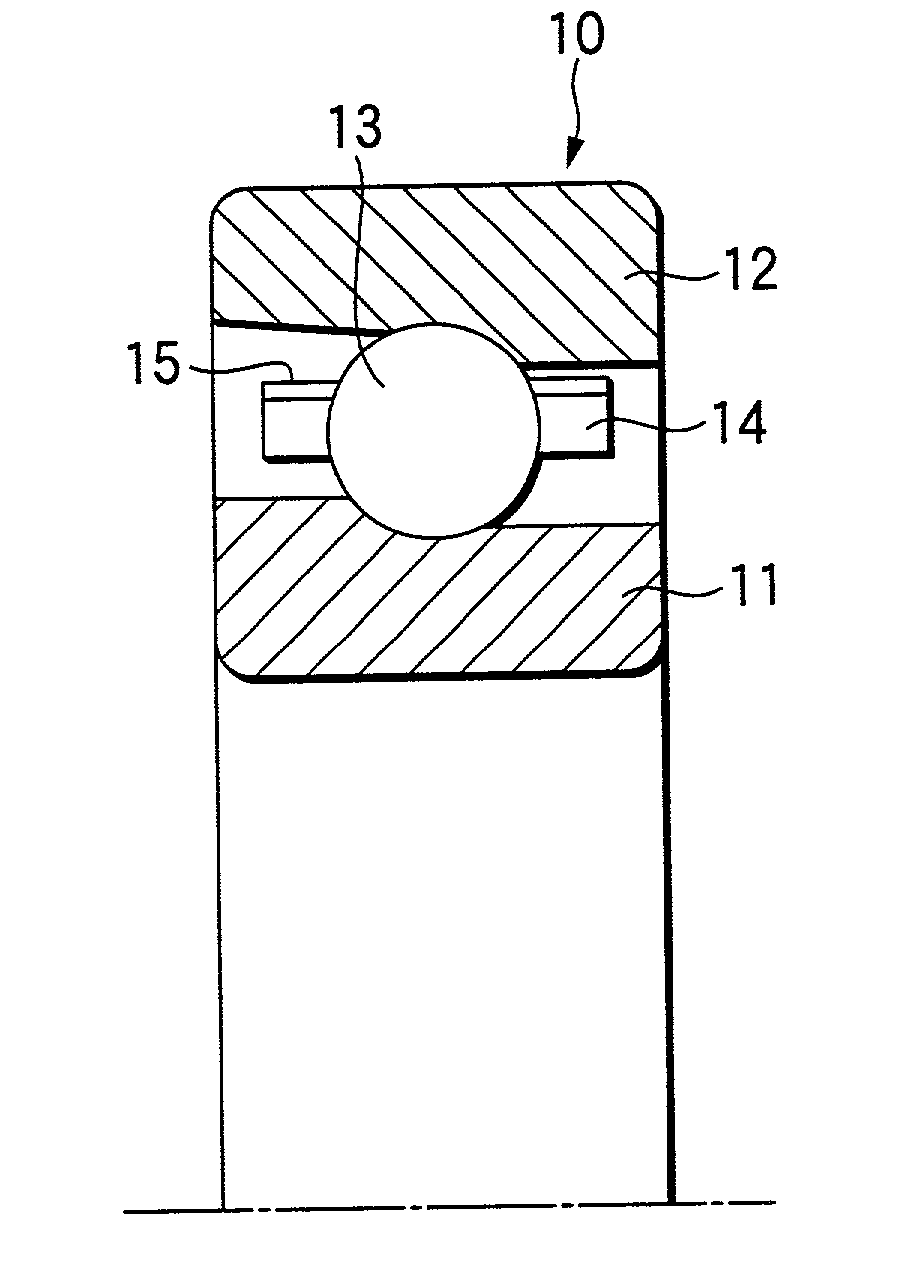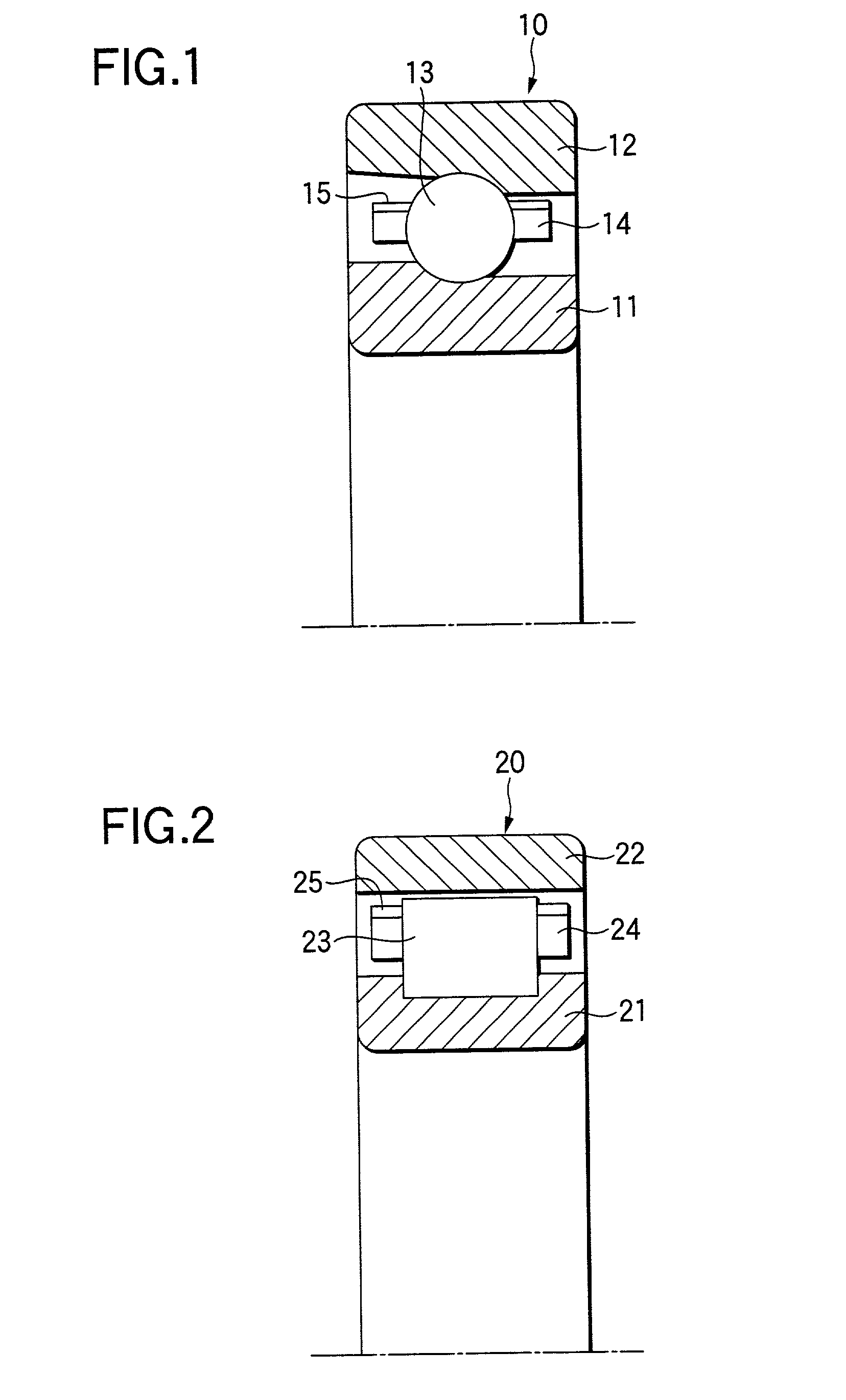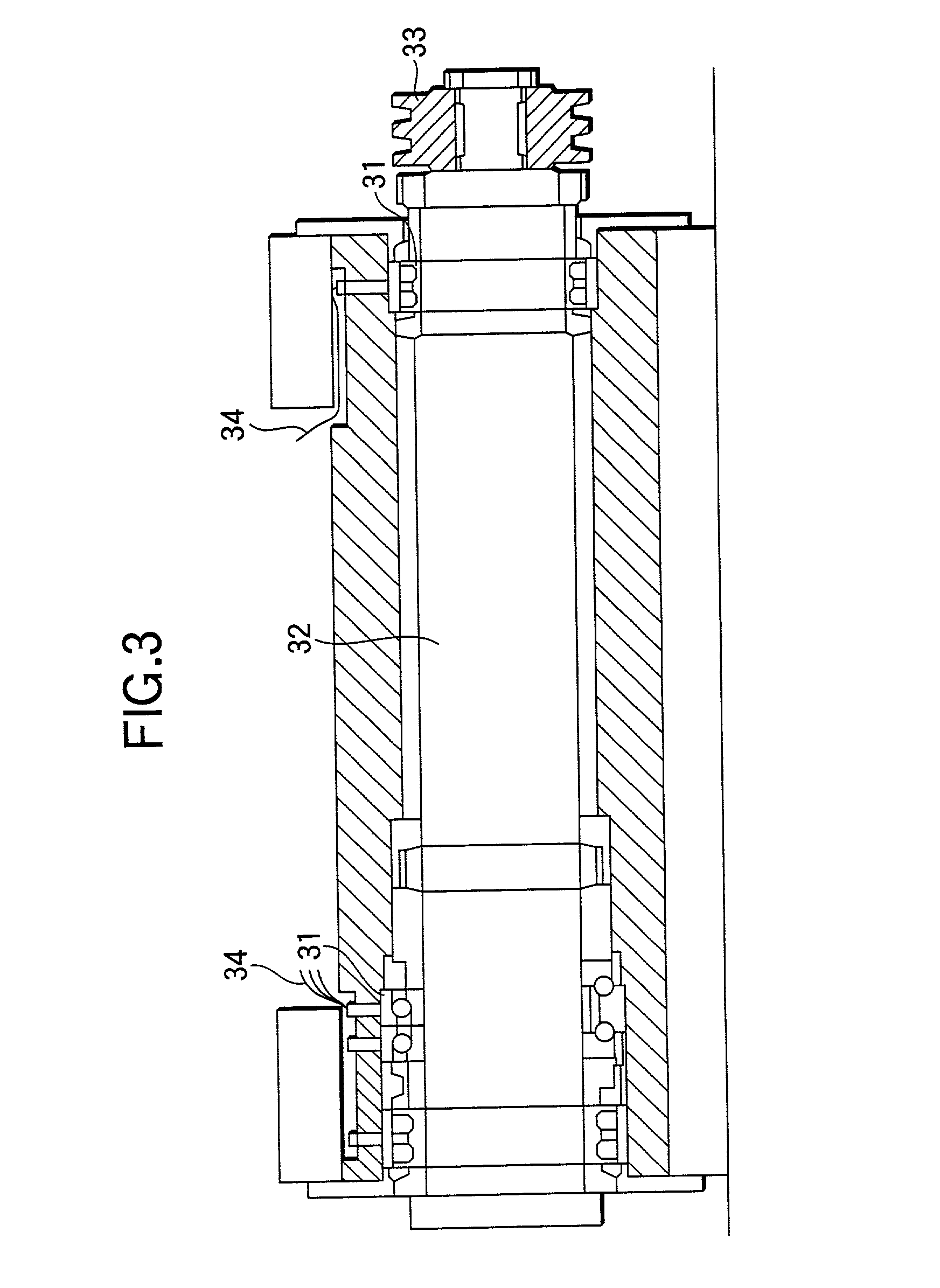However, the oil air
lubrication generates an air curtain in the interior of the bearing at high speed rotation of the bearing.
The air curtain obstructs the
lubricant entering into the rolling faces of both inner and outer rings, and brings about a problem of insufficient supply of the
lubricant.
The
grease lubrication is useful for a lubrication of the bearing only, but it has a large agitation resistance of the
grease and a large heating value of frictional heat under a condition of high speed rotation, bringing about a problem ready for causing seizure.
In this case, the same problem occurs not only at the contacting parts between the raceway surface of the bearing ring and the rolling elements, but also at the contacting parts between an outer
diameter face of the retainer and an inner
diameter face of the outer ring and between an inner
diameter face of the retainer and an outer diameter face of the inner ring.
The sliding at the contacting parts or the increase of pressure at the contacting faces generate a rising temperature or seizure by
heat generation and further various kinds of inconveniences such as advance of excessive abrasion.
However, the rotating speed of the
roller bearing trends to increase more and more, and with only the techniques disclosed above, it is difficult to cope with higher speed and the low
heat generation.
Therefore, at the high speed rotation when the DmN value exceeds about 2,000,000, an
oil film is broken at the contacting part between the balls and the raceway surface, and both are easy to contact with each other, causing a problem that damages as seizure or abrasion easily occur.
Especially, comparing with the oil air-lubrication or the
oil mist-lubrication, since the
grease lubrication is difficult to form an
oil film, the allowable rotating speed is lowered.
On the other hand, in a case that rolling sliding members such as bearings or linear guides are served under
oil free conditions as vacuum, clean
atmosphere, high or low temperatures, a lubricating manner becomes a problem.
However, the
solid lubricant has a problem that abrasion of the
solid lubricant itself is large because the
solid lubricant is self-sacrifice.
When using the conventional hard film, a life has been very often shortened because a problem is present in a lubricating property.
However, in the rolling apparatus such as the above mentioned conventional rolling bearing, a contact face is a
point contact or a line contact having a small area, and since large contact stress acts on the raceway surfaces of raceway rings or the surfaces of rolling elements, the raceway surface of the race way ring or the DLC film is probably broken by repeated stress or shearing resistance.
A first point is that the DLC layer has a property very difficult to deform even if the stress acts on.
The DLC is hard and has high elasticity, and if it is covered with a metallic material of small
elastic modulus such as a stainless steel or a bearing steel, the DLC cannot follow deformation of a base material owing to difference in both
elastic modulus, and the DLC film might be broken.
A second point is that although the DLC is expected to have lubricating property, in comparison with the grease or the lubricating oil, this property is inferior and the DLC is weak in the shearing resistance.
A third point is a problem of
embrittlement of the metallic intermediate layer interposed for heightening adhesiveness between
copper and the DLC film.
That is, because the
metal composing the metallic intermediate layer and carbon composing the DLC film are combined to form metallic
carbide having
brittleness, the metallic intermediate layer is embrittled and the DLC film is easily broken.
On the other hand, it is difficult to supply enough lubricant to the rolling member and the sliding member used in a
cooling medium as a compressor or engine parts, or to sliding members served within engines, to become a
boundary lubrication and very often cause seizure.
By the way, the lubrication with such a minor amount of the lubricant is small in an agitation resistance of the lubricant, and is a very useful lubricating technique for reducing generation of heat in, e.g., the spindle bearing of the
machine tool, but this is difficult to control the amount of the lubricant, and especially in bearings working at high speed, an air curtain (obstructing the lubricant entering into rolling faces) occurs owing to rotation, and becomes the
boundary lubrication and very often causes the seizures.
However, the liquid lubricant has a problem that rotation torque or sliding resistance are large by the agitation resistance of the lubricant.
Accordingly, a similar problem occurs also in the method of using the solid lubricant as mentioned above.
As the
fluorine based grease has a low wettability with
metal and a poor
oil film-forming ability, it easily becomes the boundary lubrication, and the rolling member and the sliding member using the
fluorine based grease have problems about the endurance.
Particularly, the usage of the solid lubricant such as the
fluorine based compound is useful for improving conformability at an initial period, but not adequate to lubrication of a long time, and its application is limited to the sliding member of very light weighted load.
The technologies disclosed in JP-A-10-326468 and JP-A-10-326469 are that since the liquid lubricating film is difficult to form under a condition where the contacting
surface pressure is high as a rolling contact, it easily becomes the boundary lubrication and easily causes the seizure and abrasion.
In particular, as the metallic surface is covered with chemically stable metallic
oxide, a problem is that the functional group of
fluoropolymer is less to combine with
metal, and
adhesive force of
fluoropolymer to the metallic surface is remarkably low.
But although having a large affinity with an
alloy steel, this compound is harder than the
alloy steel composing the bearing ring, and the rolling elements are worn under the boundary lubrication and a preload escapes.
Further, since the surface composed of the above mentioned compound has a large sliding resistance, it is difficult to prevent the seizure.
A cause of the former of "the DLC film cannot follow deformation of the base material" is because the equivalent
elastic modulus of the base material is smaller than that of the DLC film, so that when loading the stress, the base material deforms prior to the deformation of the DLC film and then the DLC film is broken.
As a result, the DLC film can follow the deformation of the base material, and the breakage of the DLC film is difficult to occur.
If the equivalent elastic modulus of the DLC is more than 240 GPa, the DLC film has a larger equivalent elastic modulus than that of the steel, and it is difficult for the DLC film to follow the deformation of the base material when the repeated stress acts on, and the breakage of the DLC film is easy to occur.
With this structure, as the DLC film of the rolling sliding member composing the rolling apparatus is difficult to be broken by large contact stress, it has a long life even if being used under the condition of acting the large contact stress or under the oil free condition.
In addition, the
diamond like carbon may be formed by using an unbalanced magnetron sputter.
Further, if the thickness of the
diamond like carbon is out of the above mentioned range, there occur problems that a seizure is caused or a self-destruction thereof happens.
As a result, the DLC layer follows the deformation of the base material, and the DLC layer is difficult to be broken.
If the equivalent elastic modulus of the DLC is more than 240 GPa, the DLC film has a larger equivalent elastic modulus than that of the steel, and it is difficult for the DLC film to follow the deformation of the base material when the repeated stress acts on, and the breakage of the DLC film is easy to occur.
 Login to View More
Login to View More 


